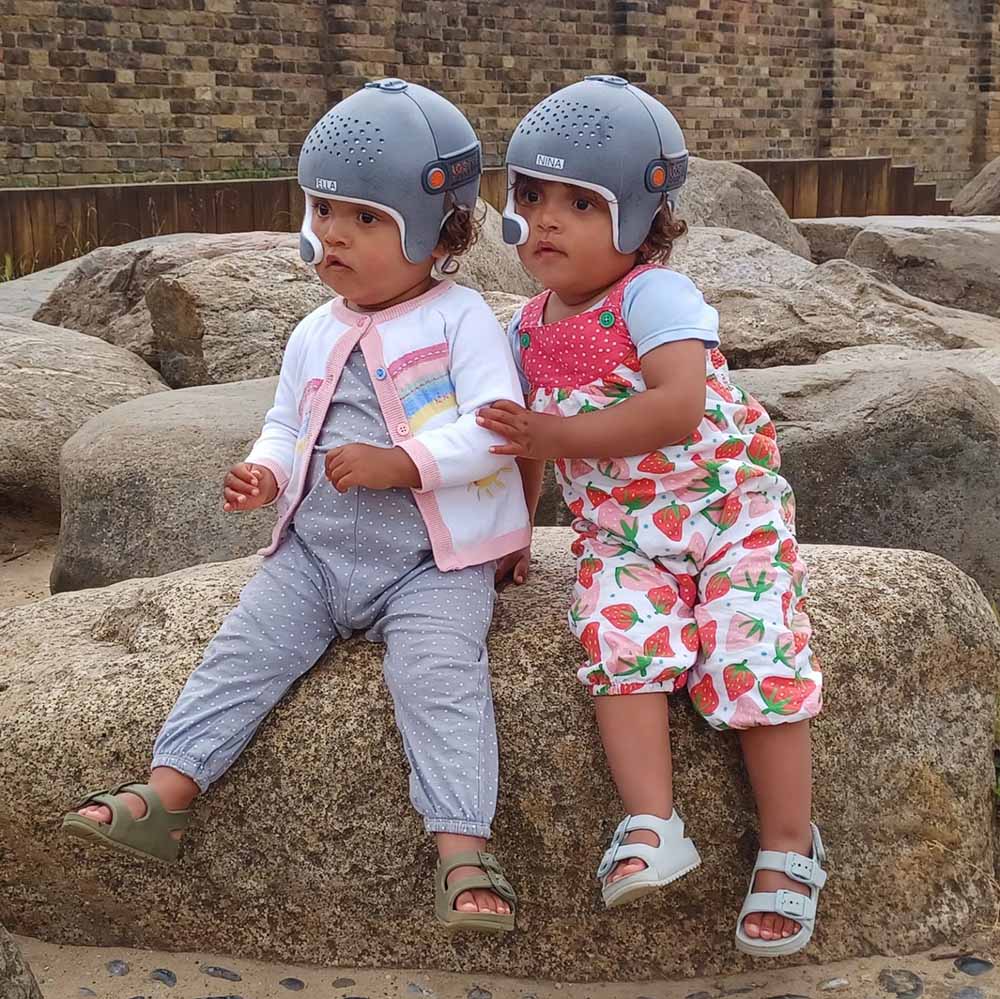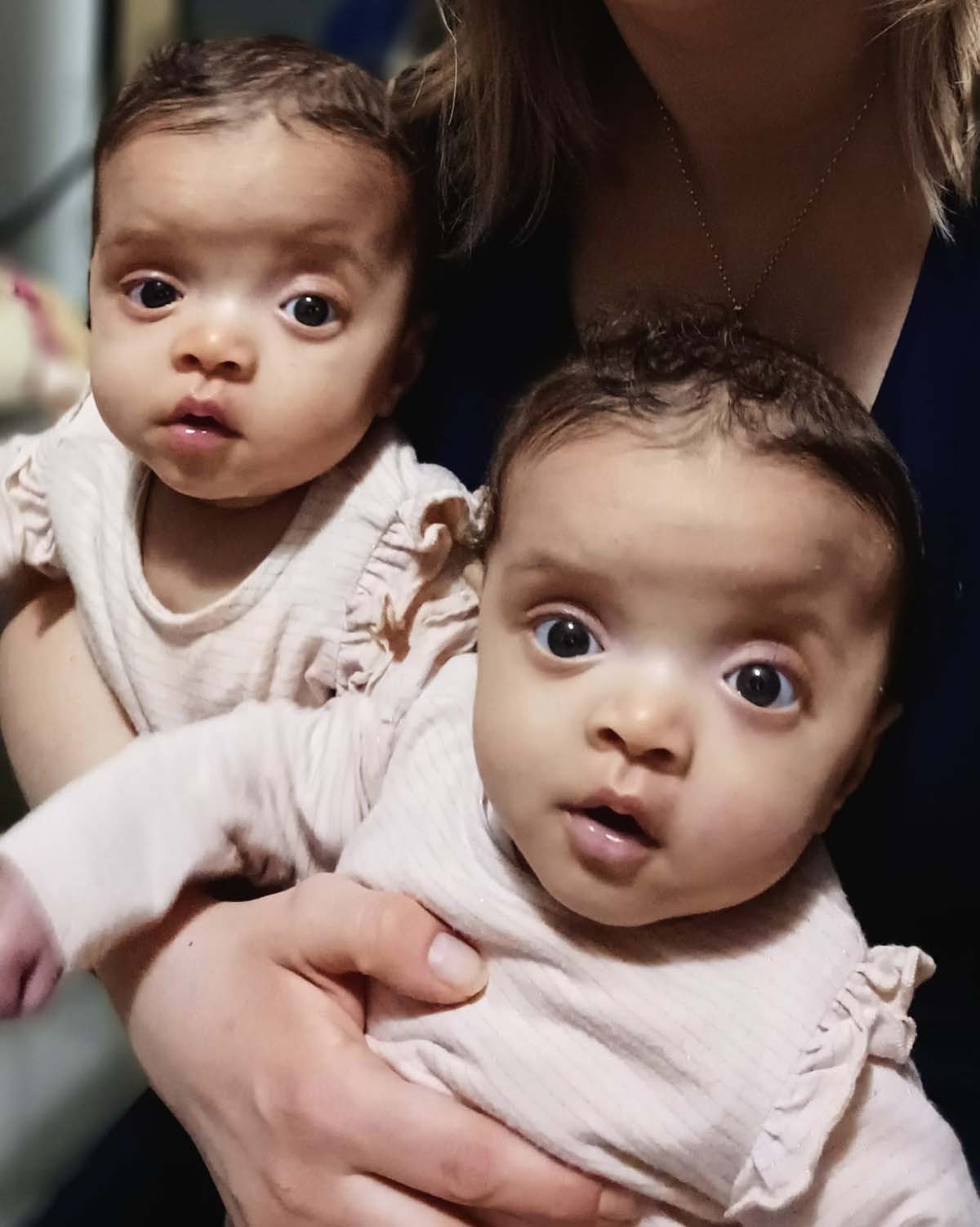
Ella and Nina wearing their bespoke cranial remoulding helmets during treatment
09 May 2024
“It wasn’t until we took our twins to be assessed by LOC that a diagnosis of craniosynostosis was even mentioned; this encounter was pivotal in getting our two daughters the specialist care and treatment they needed, and for that, we are forever grateful to Saeed for his expertise.”
Natalie recalls: “From the day our identical twins, Nina and Ella, were born, we questioned the irregularity of their head shape. They were beautiful and content little babies. However, their foreheads were more prominent than our older sons had been, and they both had one heavy-looking eyebrow, causing one eye to appear more open than the other.
Each healthcare professional we discussed this with acknowledged they could see the asymmetry but concluded it was due to being “squashed as twins” or simply just a “variation of normal”. The latter phrase, I think, will always haunt us, as I feel this conclusion was the barrier to conducting further investigations or seeking a specialist opinion.
We later became aware of the charity Cranio Ribbons UK and their campaign slogan ‘Abnormal is not always normal’ – reflecting that we are not alone as parents to struggle to get a diagnosis due to misguided reassurance about irregular head shapes. Working in healthcare myself, I suppose I instinctively trusted the conviction of the professionals we encountered – I now realise this nearly cost the girls their chance for a less invasive treatment due to delayed diagnosis."

The LOCband is non-invasive and works by applying gentle, constant pressure over the areas of the baby’s skull that are most prominent while allowing unrestricted growth over the flattened areas. The band consists of a soft foam layer inside a thermoplastic shell. As the baby grows, the band will be adjusted frequently to gently guide the skull into a more symmetrical shape.
The optimum age for treatment is between four and seven months.
This is because the skull is most malleable at this age and improvements to head shape tend to take less time and are more dramatic. That is not to say that helmet therapy should be ruled out if the baby is older than seven months. Routinely, babies up to the age of 16 months can be treated very successfully.
The cut off age is around 18 months when the fontanelles (soft spots on the head) are no longer malleable. As babies grow and develop at different rates, it is always worth checking if you are not sure. There have been cases where a baby’s fontanelles have not fused yet by the age of 18 months, who have achieved successful, but less-marked results with cranial remoulding therapy.
Yes - All babies that have completed their course of treatment with us have achieved a measurable improvement in head shape. However, you don’t have to take our word for it.
Recent independent research conducted by a University Hospital in Germany has endorsed the treatment for babies with moderate or severe plagiocephaly.
A larger, retrospective study has just been published that found complete correction was achieved in 94.4% of babies treated with helmet therapy.
The results were conclusive: repositioning achieved acceptable correction in 77.1% of cases, but 15.8% were moved onto helmet therapy because re-positioning was not working. Meanwhile, 94.4% of the infants who started in the helmet-treated group achieved full correction, as did 96.1% of those who were transferred from the repositioning group into the helmet-treated group.
Further information can be found on our Plagiocephaly Research page.
This is very much dependent on how fast your baby is growing. The faster the growth, the more frequently your baby will be seen so that the helmet can be adjusted. In general, reviews will happen at two to four-week intervals.
The price of treatment covers:
At seven weeks of age, the twins had a routine GP appointment and were referred to Bristol Children’s Hospital for review. The GP had recognised their irregular head shapes but also found their weight gain had become static. It was this second issue that became the leading focus of the three paediatric consultants Nina and Ella were reviewed by over the subsequent follow-up appointments.
“The girls both had reflux, brought on by a winter cold they had caught. They were having trouble putting on weight and I suppose the consultants just concentrated on trying to fix that problem. They did each examine their heads and took measurements but concluded the fontanelles were both open, so there was nothing to worry about.
Time passed, and at four months, we realised that their head shapes were not improving as we had been advised would happen. In fact, the asymmetry was becoming more prominent. At this point, they also had a strong preference to turn their heads and look to the right. This led to us seeking assessment and treatment from a cranial osteopath because we thought they might be suffering from torticollis.
We had read this can lead to flat head syndrome (plagiocephaly) which they also seemed to be developing on their favoured side. Around this same time, I chanced upon an ad in a magazine - Multiple Matters - produced by the Twins Trust. The ad was about twins who had irregular head shapes and how the company - LOC- treated them with special helmets. We talked about it with our osteopath and decided that it wouldn’t hurt to get a free scan.”
In March 2022, Natalie and her partner, Ryan, took Nina and Ella to LOC’s clinic in Bristol. They were assessed by Saeed Hamed, one of LOC’s founders, who immediately diagnosed the problem of craniosynostosis.
“That day was such a whirlwind of emotions – the shock and fear of hearing they likely had a condition that needed surgical intervention, the anger that it had taken a private assessment to reach a diagnosis and the panic that there were only days until the girls would reach the six-month-old cut off for endoscopic treatment.
I also felt guilty for not pushing harder for a specialist review and really let down by the system I wholeheartedly trusted. Saeed was very clear that we needed to get an appointment with Greg James and his team at Great Ormond Street Hospital as soon as possible. I was straight on the phone with the GP going into full ‘mother bear mode’ and wouldn’t take no for an answer.”

Unicoronal craniosynostosis
Craniosynostosis is the fusing of the bones in a baby’s skull too early. This happens before the baby’s brain is fully formed. As the baby’s brain grows, the skull can become more misshapen. There are five types of craniosynostosis which are characterised by which sutures have fused early. In both Nina and Ella’s cases, it was the right coronal suture that was fused too soon – causing unicoronal synostosis.
Features of this type generally include asymmetry of the skull base and face, with a displacement of the ears and lateral deviation of the nose away from the side of the frontal flattening. On the opposite side to the fuse the forehead appears prominent, and this was the first feature their parents had noticed on the day they were born.
GOSH is one of a handful of UK hospitals that offer a far less invasive surgical operation for Craniosynostosis - Endoscopic Strip Craniectomy. LOC has been working with GOSH since 2019, providing post-operative cranial remoulding therapy, very similar in principle to its treatment for positional plagiocephaly.

Two measurements are taken during the initial assessment:
Natalie reflects that although the day of surgery was very frightening for her and Ryan, with the twins being operated on in succession, to some degree, that was the easy part. The helmet therapy that followed is a lengthy process and requires considerable input from parents (doubly so with twins).
“We saw both Saeed and Jo Drake (Head of Plagiocephaly); they were such a fantastic team, always listening to our concerns, fitting in additional appointments, taking meticulous care to ensure the fit was both comfortable for the girls and effective as a treatment; it really is an artistry and fascinating to watch them calculate how the helmets needed to be adjusted to focus on specific improvements. It was evident that they really wanted the best outcomes for Nina and Ella and that they would do everything possible to achieve that.”
After 18 months of treatment, the girls were discharged. Ella’s asymmetry had reduced from 14mm to 3mm and Nina’s from 11mm to 2mm. There was also a significant improvement in their cephalic ratios: Ella’s reduced from 89 to 79% and Nina’s from 91 to 80%.
Natalie says: “It’s truly amazing. We had identical twins born with identical fused sutures who have undergone the exact same treatment, both with a fantastic outcome. This is all thanks to the expertise and commitment of the teams at both GOSH and LOC – and the strength and spirit of our incredible girls."
If you’re concerned about the development of your child’s head in terms of its shape and size, or concerned that your baby may have craniosynostosis, fill out our free flat head diagnosis form or contact us to book a free consultation with an orthotist.

Ella’s head scans before treatment show an asymmetry value of 14mm, and after with a value of 3mm

Nina’s head scans before treatment show an asymmetry value of 11mm, and after with a value of 2mm